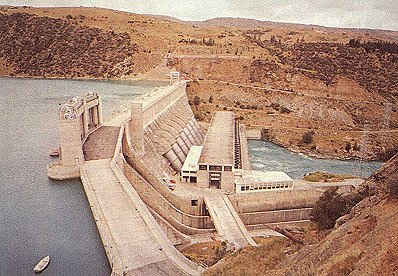![]()
Coasts
Rivers/Lakes
Lowlands/Plains
Geysers/Mud
Glaciers
Mt. Ruapehu
Mt. Cook
White Island
A Maori Legend
![]()
Abbotsford
Aramoana
Ballantynes
Brynderwyns
Cave Creek
Hawkes Bay
H.M.S. Orpheus
Influenza
Mt. Erebus
Mt. Tarawera
Rainbow Warrior
Seacliff Hospital
Tangiwai
Wahine
![]()
Annie Aves
Ata-hoe
Daisy Basham
Jean Batten
Minnie Dean
Mabel Howard
Margaret Mahy
Kath Mansfield
Kate Sheppard
Kiri Te Kanawa
Catherine Tizard
Murray Ball
Charles Goldie
Edmund Hillary
Richard Pearse
Lord Rutherford
Charles Upham
![]()
NZ FAQ--Funny
NZ Links
Credits
New Zealand's longest river is the Waikato which flows for 425 kilometres through the central North Island before entering the Tasman Sea. The Waikato flows impressively from Lake Taupo plunging over the Huka Falls then travelling to just south of Auckland where it meets the sea. The last huge Taupo eruption was responsible for changing the course of the river. Before 135 A.D. the Waikato flowed out on the other coast into the Firth of Thames.
The Waikato has always been important providing an easy trade and access route for both Maori and European in early times. Today barges still carry sand and shingle down the river near Hamilton and it is the chief source in the North island for hydro-electric power. The eight hydro-electric power stations lining the river have virtually turned the river into a series of artificial lakes and it is vastly popular for water skiing, boating and fishing for trout. Our second longest river, at 388 kilometres, is the Clutha which discharges the greatest volume of water of any river in the country and empties into the Pacific Ocean. Clutha is old Gaelic for Clyde and the name was used by early settlers who originated from Clyde in Scotland. The Punakaiki River though not important for its length or volume is famous for the unusual rock formations to be found at the mouth of the river. Also known as the Pancake Rocks, by people who can't get their tongues around the Maori pronunciation, these giant limestone formations look just like stacks of enormous pancakes. The hard limestone that forms the rock is relatively resistant to marine erosion but over time wave action has etched out thin layers leaving the pancake effect. In heavy seas water rushes into caverns and chambers under the rocks producing blowholes, geysers and waterspouts. Rumbling and booming sounds are greatly amplified by the caves and on a rough day the sight is spectacular.
|



